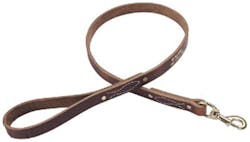Equipment selection can be a difficult thing. For general duty equipment, your agency may specify a specific manufacturer and finish, which makes things easy for the common officer working the streets. Hopefully, the command staff that has made those decisions actually tested the equipment, read reviews on the equipment and made an educated and informed decision. If you are not given specifications other than a finish, such as basket weave or nylon, then it is your responsibility to do the aforementioned research. When you get assigned to the K-9 unit, you have more equipment to consider. Other K-9 unit members can be of help in recommending equipment, and who knows? You may be issued equipment. Like every other piece of equipment, you must inspect it, especially if it is department issued and used. Make sure that your equipment, like you, is fit for duty; if it isn’t then replace it.
I have my own personal preferences on manufactures of my duty gear, tactical gear, footwear, uniform, and of course my K-9 gear. If you have your choice of manufacturer, do your research; talk to other K-9 officers as to what they do or don’t like and why. Try out different styles and materials of lead, collars, etc., and make your own educated decision.
When it comes to selecting your K-9 gear, there are numerous manufacturers out there, but you want to go with one that is specific to working dogs. The stuff you find at your local pet store is garbage, in my opinion, when comes to a working dog. The stresses that the collars and leads will be going through will cost you or your department a lot in continually replacing equipment purchased from the pet store. You may pay more initially for the professional grade, but it will last you a long time - possibly your whole K9 career. I have had a 5 foot heavy duty leather lead for about ten years and it is in great shape.
Personally, I’m not a fan of nylon leads unless it is a long tracking lead. In comparison, nylon is lighter and more flexible than leather, making it ideal for a tracking lead. For traffic leads, agitation leads, etc., leather is the way to go. I have tried some of the synthetic leads that have a rubberized coating. They do help with grip when in wet conditions, but I’m still a fan of leather leads. When it comes to strength, leather vs. nylon, leather wins in my book. When stressed, a nylon lead can stretch - not much but it can - whereas leather isn’t going to stretch. Also, when you’re going through the bushes trying to find that suspect, that nylon lead will get snagged on every single thorn and have all kinds of stuff stuck to it; leather generally won’t give you that problem.
For all my leads, I prefer the common bolt snap. Bolt snaps are strong and have very few working parts, so there are less pieces and parts that can fail. I’ve tried others, but always come back to the bolt snap. Another thing to consider is how the snap is fastened to the lead and how the loop handle is made. There are several ways the manufactures do it. My least favorite, and is probably what you will find at the pet store, is the lead is just sewn on. Then there are the braided leads. I’ve had one, and looking at it, I still haven’t figured out how they braid it, but they do. Don’t get me wrong, they are good and they are strong, but not my preference. My thought on it is this: they have sliced the leather in the middle making several slots to braid it. I see it as diminishing the strength of the lead. It looks cool, but we aren’t out there to look cool (in spite of popular opinion). It may be plenty strong, but I won’t be using one. The leads I use are all sewn and riveted. They are also seven-eighths-inch wide and nearly a quarter-inch thick, with bronze bolt snaps.
When it comes to collars, again, get high quality stuff. You don’t need your K-9 biting someone because your equipment failed to restrain him/her. When it comes to collars, I prefer the fur-saver choke collars and leather agitation collars. Fur-saver collars have longer links, more like a tow chain, that don’t pinch the hair as much, preventing or cutting don’t on the hair being broken off. Leather agitation collars are generally about two inches wide, which spreads the force/load on the K-9’s neck. K-9’s are very powerful, and when pulling against the lead, can put a lot of force/load against their throat and neck. A narrow collar would put more stress on them and possibly cause injury.
Then there are the harnesses. I’ve only had leather harnesses, and seeing how I’ve had no issues with them, I see no reason to get a nylon harness. Like the collars, I also have criteria for the harness. Of course it must be of high quality material. The straps going across the chest must either be wide to spread out the force, or if they are narrow, have a chest pad that will spread the force. If you’re looking to getting a nylon harness, keep the above criteria in mind, but also look at those that are modular. Many of the modular one’s are similar in construction to a SWAT vest: they are heavy duty and are adaptable to the situation at hand. Keep in mind though, that the ones that are more like a vest than a harness cover more of the dog and will increase your K-9’s temp, especially in hot climates.
Would you go on duty with sub-standard equipment? I think not. Don’t purchase sub-standard K-9 equipment. That four-legged animal isn’t just a dog, s/he is your partner, there to protect and assist you, and deserves high quality equipment.
Stay safe.
About the author:
Steve Forgues started his career over 18 years ago in Arizona. Over the years, Forgues has worked contract security, police, corrections and tactical operations. Forgues has been an instructor in various disciplines since 1998, and has been working and training with canines since 2000. Forgues has also been writing for law enforcement since 2005. He is currently working as a police officer and firefighter in Pennsylvania.
About the Author
Steven Forgues
Steve Forgues started his career over 18 years ago in Arizona. Over the years, Forgues has worked contract security, police, corrections and tactical operations. Forgues has been an instructor in various disciplines since 1998, and has been working and training with canines since 2000. Forgues has also been writing for law enforcement since 2005. He is currently working as a police officer and firefighter in Pennsylvania.

